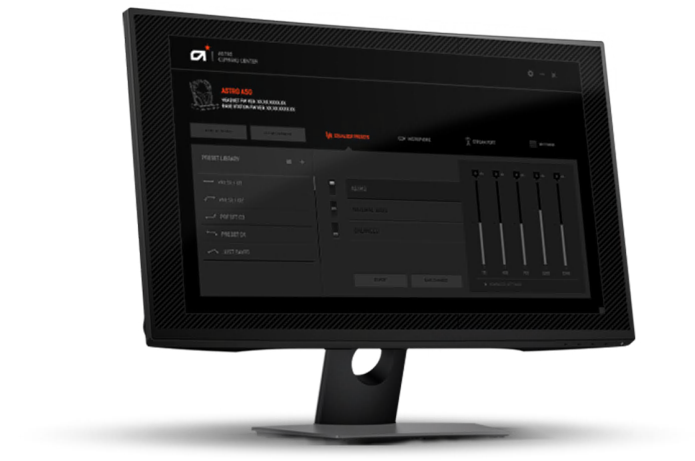ASTRO Command Center Software. The free ASTRO Command Center software gives players complete control over their audio experience, which includes voice communication and game audio settings. Available on Windows 10, XBox and Mac. Empowering Content Creators. Elgato Gaming Downloads. Connection Issues. We are unable to fetch information from our download server. Astro Command Center Not Detecting A40 Best astrology softwares:- Since the onset of technology, computers have made our lives much much simpler. We can now carry out complicated tasks and calculations right on our computer without wasting too much time, which comes in very handy. ASTRO Command Center lets you configure your ASTRO gaming hardware. Using this application, you can update the firmware and customize the input and output settings of MixAmp Pro TR and other devices. Stream settings can be used to adjust Game Volume, Chat Audio, Microphone and AUX channels individually for a mix that works in any environment.
© Provided by Windows CentralEven without an optical port, you can still get great sound.
The Astro A50 and Astro A40 are two of the best and most popular gaming headsets for the Xbox One, and Astro has committed to making it as easy as possible to also use them on the Xbox Series X or Xbox Series S. However, since the new consoles lack the optical port that has traditionally been part of all of Microsoft's systems, you'll need to update Astro A50 and A40 headsets, so you use them through the USB port.
Not sure what you need to do? We've provided step by step instructions for the required firmware update so you can enjoy the best sound with all the next-gen games.
How to update Astro A40 and Astro A50 to work with Xbox Series X and Series S


- Connect your MixAmp Pro TR (often paired with Astro A40) or Astro A50 Base Station to your PC or Mac over USB. If using an Astro A50 headset and Base Station, ensure the headset is placed on the Base Station and charging.
Visit the Astro Gaming site and download the Astro Command Center software for PC. A Mac version is also available.
© Provided by Windows CentralInitialize the Astro Command Center Setup Wizard to install the software.
© Provided by Windows CentralChoose a destination folder for your software. It will default to program files.
© Provided by Windows CentralClick Install to begin the installation.
© Provided by Windows CentralYou'll receive a pop-up indicating the Setup Wizard is completed. Click Finish.
© Provided by Windows CentralAt the top of the Command Center dashboard, you'll see what firmware version your headset is currently using and a notification that an update is available. Click update now.
© Provided by Windows CentralThe Command Center will display details on everything that's in this version of the firmware and ask if you want to proceed. Click update.
© Provided by Windows CentralWhen the installation is done, you'll receive a notice that the update has completed. Click OK.
© Provided by Windows Central

Upon successfully updating, your Astro devices will work over the Xbox Series X or Xbox Series S integrated USB port. Simply unplug your headset from your PC or Mac, and reconnect it to your Xbox console via an USB port.
Sound on!
Once you've completed these steps to update Astro A40 and Astro A50 to work with Xbox Series X and Series S, you'll be able to use your trusty headset to play on the new system. If you have any other concerns about changing console generations, let us know in the comments.
Xbox Series X/S

Mac Astro Command Center Download Software

Astro A10 Software Pc Download
But there are still problems. I wanted to buy a Logitech G710+ mechanical keyboard, which necessitated using Logitech Gaming Software (LGS) to access the extra keys. So I temporarily put Steermouse away and gave this a shot, since LGS 'takes over' any Logitech hardware that it sees.
* Even though LGS installs a couple of extension .kext files, if you quit LGS, custom mouse buttons stop working. So you must have LGS running all the time. It can be hidden in your Dock after booting, but if you ever need to launch LGS to adjust something, there will be a giant 'G' sitting in the Dock until you reboot again.
* LGS didn't display the G700s' left/right mouse-wheel tilt in the UI, so nothing could be assigned. There is a workaround to return all of a profile's settings to defaults--then, even though the wheel tilt areas don't light up when moused over, at least the assignments are floating in mid-air, and you can right-click on those to re-assign. This bug was discussed several months ago on the Logitech forums, and acknowledged. No fix since, however.
* No acceleration controls, just DPI and polling speed. On a hunch, I discovered that the built-in OS X preference pane Mouse > Tracking Speed may be intended to work alongside LGS. Setting that to the 2nd or 3rd notch worked.
* After boot, wake from sleep, or even coming back from a screen saver, LGS takes several seconds to 'wake up' and start working. Your mouse will be glacially slow during this time, unless you used default DPI settings (not likely), and custom button assignments will not work.
* When assigning a key-press with modifier (for example: Shift-M) to a mouse button, LGS seems to put a lot of extra milliseconds in between them, leading to very strange results in some apps.
* The clincher: The 'G' menu bar item finally crashed, and caused everything after it in the menu bar to stop responding. I got caught up in my work, thought it was only 9:35 pm, but it was actually near midnight. The clock display was frozen.
LGS uninstalled.
Logitech would be wise to take software development seriously, and stop farming it out to someone who only turns in updates when they can be bothered to, once per year. Logitech support staff seems to be at the mercy of this mystery developer, who may or may not even address the list of bugs collected by the time new Logitech hardware and a new version of OS X may be causing more. And who is doing QA on this software, if at all? It didn't take me more than one day to document everything here.
As a direct result of the above issues, I bought a Matias Tactile Pro keyboard instead of the Logitech G710+. It requires no drivers, has a full set of Apple-style keys (except F19) ready to assign to whatever, and my G700s mouse can return to Steermouse control. Everything works perfectly.
